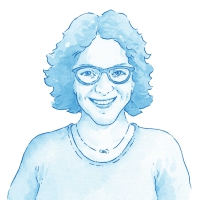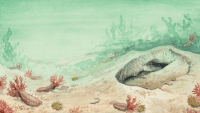
Grab Sampling
Not all seabed life is immediately apparent. As well as the familiar sea stars and crabs that dwell on the seabed surface, there are hundreds of thousands of tiny animals that live inside soft seabeds. We sample these by using sediment grabs to remove a chunk of the seabed, along with the animals that live in it. We then look at the grab sample under the microscope and identify the animals present. This can tell us a surprising amount about our marine environment.
Dive DeeperTechnology Interview
What lives in mud and sand?
In areas with soft sediment such as mud and sand, we can’t see most of the life that’s present. Hundreds of thousands of tiny animals live buried down in the seabed. Animals that live in the seabed are normally small. We call them benthic infauna: benthic refers to anything occurring at or in the bottom of a body of water, while infauna are the creatures that live in the sediments. These tiny creatures are crucial to a healthy environment. They recycle organic matter, filter water, and provide food for larger species such as fish and crabs. Many different groups of animals live in the sediment but some of the most common are worms, molluscs, and small crustaceans.
How big are these animals?
We benthic taxonomists have a funny idea of size. We call animals less than 0.063 millimetres microfauna (“small animals”). Animals between 0.063 and 0.5 millimetres are called meiofauna (literally “medium-sized animals”), and anything over 0.5 millimetres are macrofauna (“big animals”). But size is all relative—they would all seem pretty tiny to a non-biologist! If we want to study these communities, we need to get them out of the mud and under the microscope, so we sieve our seabed samples through a mesh sieve. We use either a 1 millimetre or a 500 micrometre (0.5 millimetre) mesh, depending on the study. We keep anything that’s retained on the sieve to look at under the microscope.
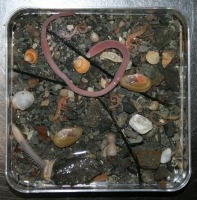
Many different species live buried in the seabed. (Photo: Huntsman Marine Science Centre)
How do you sample these communities?
To get our chunk of the seabed we use a grab or core sampler. There are lots of different designs of sampler but they’re all used the same way. They’re lowered to the seabed and the impact with the seabed triggers them to scoop or close. When they’re hauled up, a sample of the seabed is held inside them. These samplers are made of metal and can be very heavy, so we usually use a winch to operate them from the boat.
What happens to the grab sample after it’s collected?
The work doesn’t stop when we have the sample on board. First we take any samples we need for sediment chemistry or particle size analysis. Then we put the sample in a bucket and add water to make it sloppy. We put this slop through sieves, either 0.5 millimetre or 1 millimetre. We use a hose to wash off the fine sediment. This part can get very messy! We wear rubber boots, gloves, and waterproof clothing to keep the worst of the mud off us. Finally, we get our sample: sediment and animals that have been retained by the sieve. We put this in a jar and add preservative (usually formalin) to stop the animals from decomposing. When we get the sample to the lab we have to sort it, which is removing all the animals from the sediment. Then the fun of identifying can begin.
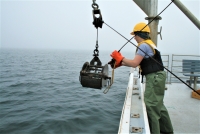
Huntsman researcher Claire Goodwin deploys a grab sampler. (Photo: Huntsman Marine Science Centre)
What do you use information on seabed species for?
The species data we collect can tell us a lot about an area. If we have samples from different times and places, we can compare them to see if there are any differences in the communities. Are there fewer or more species? Have the proportions of different species changed? There’s natural variation in benthic communities, because composition is affected by seasonal life cycles. They also vary depending on the type of sediment: some species prefer sand, but others love mud. However, environmental changes, either natural (such as storm disturbance) or human induced (such as pollution), can result in big changes in communities. This can provide us with a red flag that something has happened.
What do seabed community changes tell us?
Some species are very sensitive to disturbance. If these species vanish, it’s a clue that an area has been impacted in some way. Other species are very tolerant and can live just about anywhere. We can design studies to answer various questions. In our research we’ve used benthic samples to see how fish medicines affect the environment by comparing samples before and after the medicines were used. Samples can also be used to monitor Marine Protected Areas. If the protections are working, the communities shouldn’t change too much, although there will be some natural variation. We must plan every study very carefully. We have to make sure we take enough samples to prove whether or not the variation in community is more than just natural variation. That means looking through an awful lot of mud!
What do the pockmark seabed species tell us about this area?
We looked at whether the communities inside the Passamaquoddy Bay pockmarks were different than outside them. We found that communities inside the pockmarks had lower species densities and lacked species found in more established communities. This shows that benthic communities are probably being removed when the pockmarks are formed and have to re-establish themselves.
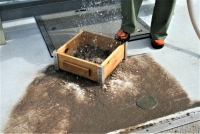
Before being examined, the animals have to be sieved out from the seabed sediment. (Photo: Huntsman Marine Science Centre)


